Focus on Physics
Refraction
The Science Teacher—April/May 2019 (Volume 86, Issue 8)
By Paul G. Hewitt
A triumph of Einstein’s special relativity theory was the discovery that the speed of light in free space is a constant. To emphasize this fact, the speed of light is denoted as c—a definite constant. But light travels slower in a material medium. Even in the atmosphere around you, light travels a bit slower than it does in a vacuum. The very small slowing of light in air is ignored when we round off its speed to c.
The slowing of light
We discussed the slowing of light in glass in the May 2018 issue of The Science Teacher, in which we followed the path of a photon through a series of absorptions and reemissions that occurred as it passed through a transparent medium. Now we’ll explore light as it moves from one medium to another with the intriguing result of different speeds—the bending of light we call refraction.
The bending of wavefronts
Think of light in terms of wavefronts that show light bending as it travels from air to water (Figure 1a). The wavefronts shown in red represent wave crests of light. The blue arrow is a sample ray of light, always at right angles to the wavefronts. The direction of the light waves changes when one part of a wave enters the water before the part still in the air and slows down. Hence light undergoes a change in direction, as indicated by the blue ray. After light bends at the surface, it continues in a straight line in the water at the slower speed, assuming there are no changes in the water that affect speed. This is refraction.
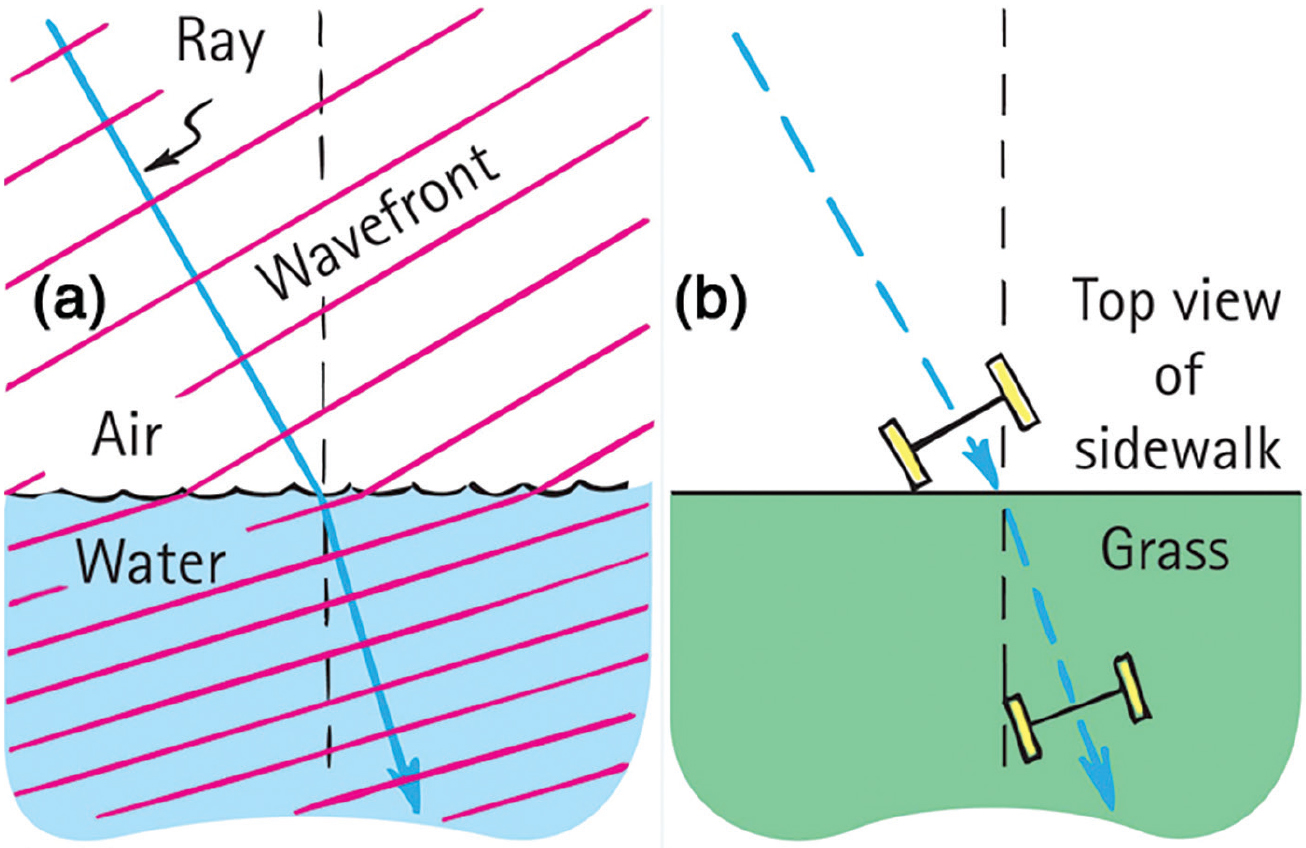
Direction changes as (a) light slows in water, and (b) wheels meet grass.
The slowdown and change of direction of light is akin to the behavior of a pair of toy cart wheels rolling down a slight incline from a smooth sidewalk to a patch of grass (Figure 1b). Wheels roll slower on the grass than on the sidewalk due to their interaction with the blades of grass. When the wheels encounter the grass-sidewalk interface at an angle, one wheel will meet the grass while the other wheel is still on the sidewalk. The wheels then swivel from their straight-line path. Due to the change in speed, the direction of the rolling wheels is bent toward the normal (the dark dashed line perpendicular to the grass-sidewalk border). Once both wheels roll on the grass, they proceed in a straight line at the lower speed.
Notice in Figure 1a that wavefronts in water are closer together than in the air, which tells us that the wavelength of the waves is somewhat compressed. Although the wavelengths of waves change with changes in wave speed, it’s important to know that the frequency of the waves remains the same. Frequency is determined by the light source. A change from one medium to another doesn’t affect it. The color of your swimsuit before you dive into the water is the same color when you are beneath the shallow water surface. (That’s because the color-sensitive cones in the retina of the eye react directly to frequency, not wavelength.)
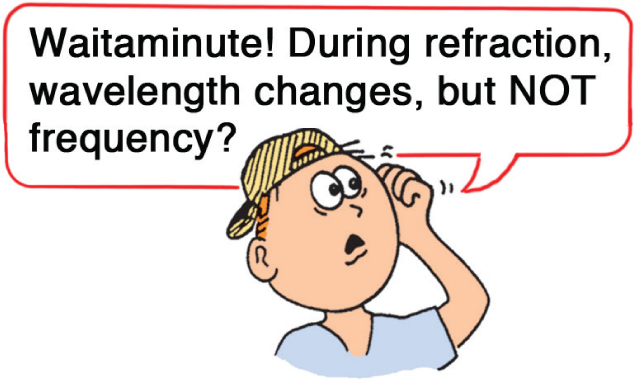
Refraction of sound in air
Sound waves refract when parts of the wavefronts travel at different speeds. This may occur when sound waves are affected by uneven winds, or when they’re traveling through air of different temperatures. On a warm day, the air near the ground may be appreciably warmer than the air above. Sound travels faster in warm air, so the speed of sound near the ground increases. Sound waves bend toward a region in which their speed will be slower, so therefore they tend to bend away from the ground, resulting in sound that does not seem to transmit well (Figure 2).
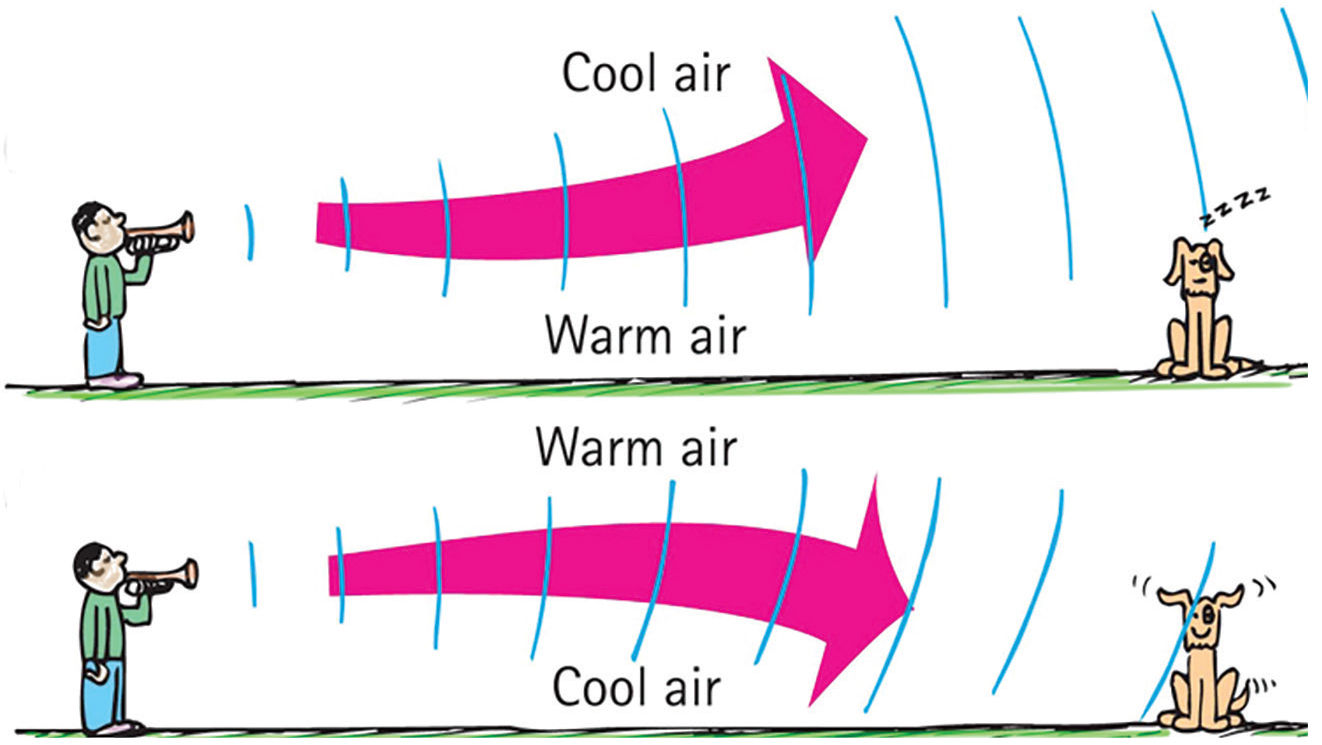
Sound waves are bent in air as speed changes with different temperatures.
Refraction of light in air
Light travels a bit faster in less-dense air than in denser air. When you’re driving on an asphalt road on a hot day, the air just above the road is hotter and therefore less dense than the air farther above it. Under this condition, seeing a mirage is a common experience. The road ahead may appear to be wet, yet when you get there, the road is dry. The explanation for this is similar to the bending of sound waves.
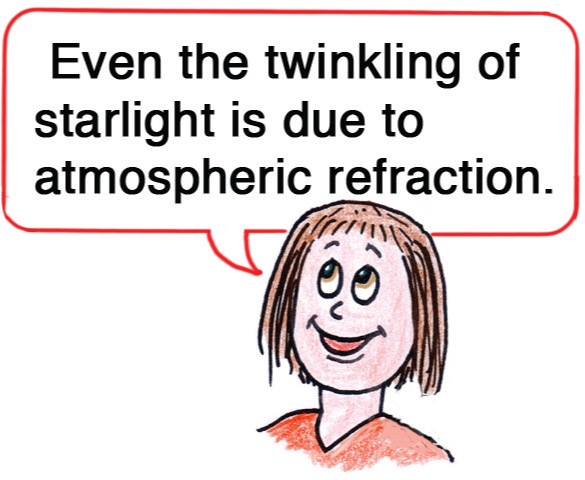
Rather than light reaching us in straight lines as it would in constant-density air, when traveling through the hotter region near the road, the wavefronts of light speed up and curve upward before reaching our eyes (Figure 3). Where we see “wetness,” we are really seeing the sky. We are not seeing a mirror image of the sky, as an actual wet patch would show, but light refracted by the warmed air near the ground. Refraction, not reflection, accounts for the “wet” road.

Light from the sky picks up speed in the air near the ground and curves upward, producing a mirage.
Sunsets and sunrises
Sunlight refracts as it travels from the vacuum of space into Earth’s atmosphere. As its wavefronts graze the upper atmosphere, light bends downward (Figure 4). This means we see the Sun higher in the sky than it actually is. Atmospheric refraction explains why we see longer daylight time than we would without refraction. When we see the Sun touching the horizon at sundown, it has already dropped below it (or, strictly speaking, Earth has already turned away from the Sun). And when we see a sunrise, the Sun has not yet reached the horizon; it’s below it. Atmospheric refraction often deceives our senses.
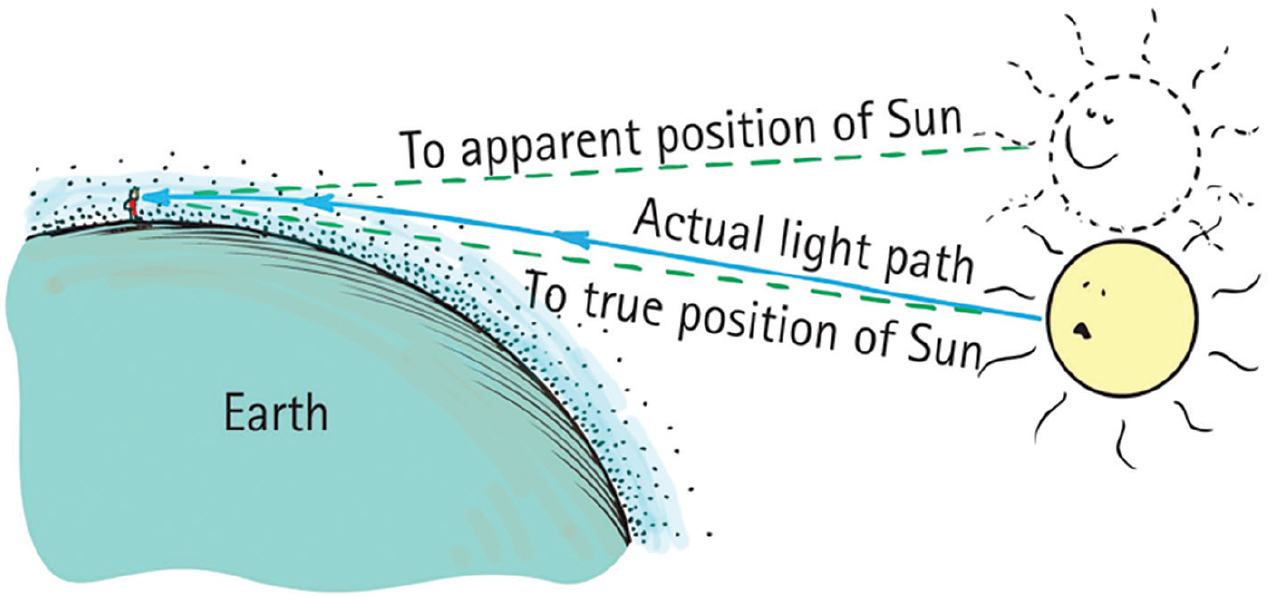
Light bends toward Earth when grazing the atmosphere.
The colors of sunsets and sunrises
The familiar oranges and reds of the sky occurring at sunrise or sunset are due to the absence of higher-frequency blues and violets. There’s no blue or violet in sunset colors because higher-frequency sunlight has been scattered by tiny molecules in the atmosphere to provide the blue skies of midday hours. When the Sun is close to the horizon, light that grazes Earth’s surface is mainly lower-frequency reds and oranges that survive scattering. Hence the reddish-orange colors of sunrises and sunsets.
An atmospheric band of color
At any given time, half of planet Earth is in sunshine. In regions where day meets night there exists a full-circle band of reddish-orange sky—Earth’s sunrises and sunsets. All objects in sunlight cast a shadow and Earth is no exception. From this colorful part of the sky, sunlight is refracted into the dark region of Earth’s shadow.
The eclipsed Moon
Normally, when we look at the night sky we don’t see this refracted light. But during a lunar eclipse, when the Moon passes through Earth’s shadow, we see this reddish-orange light reflected from the Moon’s surface (Figure 5). So when you see a reddish Moon during a lunar eclipse, you’re viewing the refracted light of all Earth’s sunrises and sunsets (Figure 6). Refraction can be awesome!
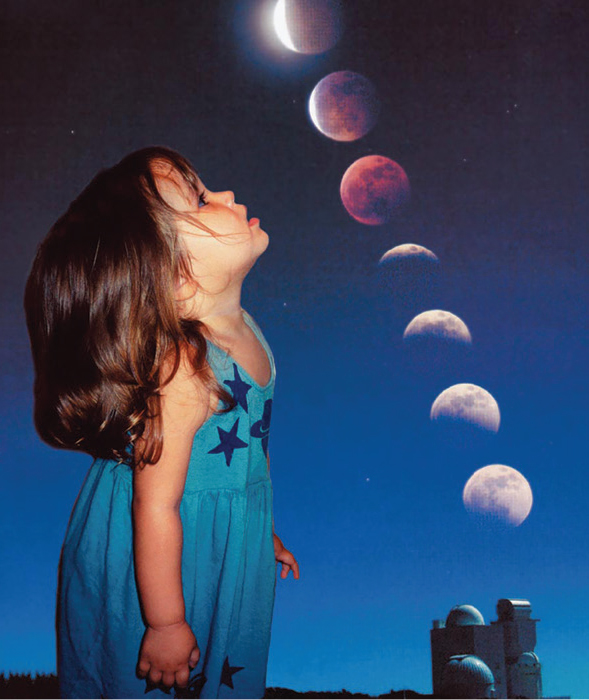
Gracie Hewitt wonders why the Moon turns red.
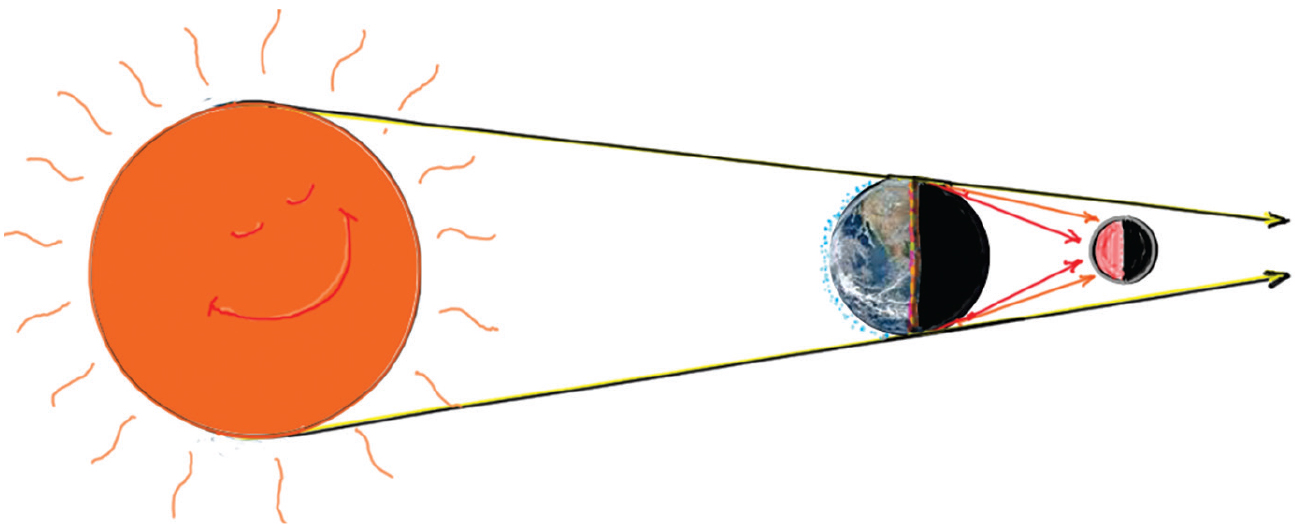
Sunsets and sunrises worldwide refract onto the Moon during a lunar eclipse.
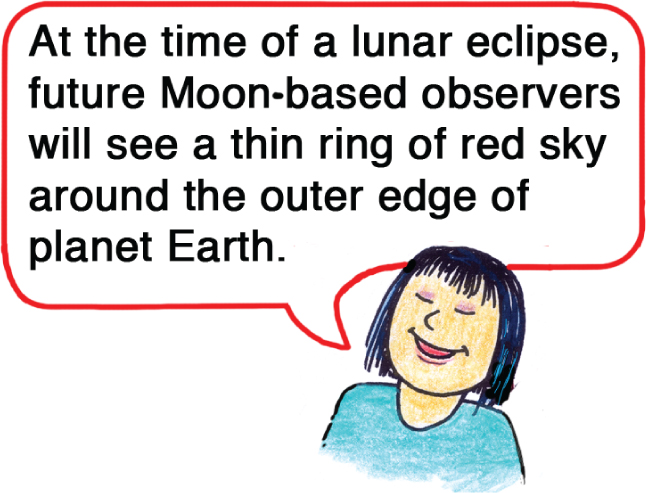
Paul G. Hewitt (pghewitt@aol.com) is the author of Conceptual Physics, 12th edition; Conceptual Physical Science, 6th edition, coauthored with daughter Leslie Hewitt and nephew John Suchocki; and Conceptual Integrated Science, new 3rd edition, with coauthors Suzanne Lyons, John Suchocki, and Jennifer Yeh.
Curriculum Physical Science Physics High School


